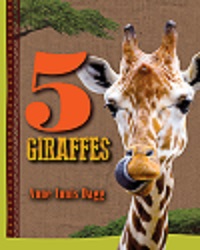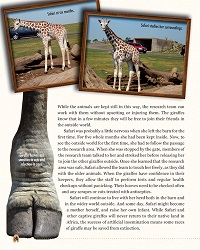| ________________
CM . . .
. Volume XXIII Number 18. . . .January 20, 2017
excerpt:
Another zoo giraffe, Gemina, merits interest for the distinctive bump that developed on her neck giving her a loyal fan following for over 21 years. In Gemina’s case, her captive existence probably extended her life since her deformity may soon have drawn the attention of predators. The stress of life in the wild is the focus of the third story of F008, another Rothschild’s giraffe who exhibited highly social but previously unobserved behaviour when her first calf died and she stayed to mourn it. Researchers learned how captivity can alter natural behaviour and communication among giraffes. The fifth story, starring Msitu, describes efforts to stimulate captive giraffes with activities to make life more interesting. They can be trained to respond to simple commands, for instance, to allow staff to monitor health more easily. These stories bring the reader into personal contact with each giraffe in an engaging way, helping to evoke empathy for the plight of the species. Up-to-date details show how interactions with captive giraffes have enabled scientists to better observe and protect them in the wild. Readers will be fascinated to learn that a giraffe’s unique pattern of spots simplifies identification from photos, much as west coast orcas are identified and tracked by the shape of their black and white patches. While presenting the commendable objectives of zoos to help us learn about animals like giraffes, the author argues that today’s technology makes zoos unnecessary. Rather, she supports a wild existence with ample space in a natural climate, among others of their own species to allow natural behaviour. The last chapter, however, issues a dire warning about the future of wild giraffes coping with pressure from increased human activity in their natural environments. Suggestions are offered for readers to become involved with safeguarding giraffes and spreading the word about their risky future. One example highlights World Giraffe Day, celebrating “the animal with the longest neck on the longest day of the year”—June 21. Top quality, appealing photographs strengthen the book, allowing the reader to closely examine details discussed in the text. A couple of maps are included to show locations of threatened populations. Sketches augment the description of how a giraffe walks and gets up. The book is cleverly designed with photos framed with different shapes and using various placement on the pages to enhance interest. 5 Giraffes offers a wealth of detail about giraffes in a well-presented package, and its attractive, easy to access design will encourage careful reading. It is part of a series, “5 Animals”, that includes 5 Elephants by Rob Laidlaw. Highly Recommended. Gillian Richardson is a freelance writer living in BC.
To comment
on this title or this review, send mail to cm@umanitoba.ca.
Copyright © the Manitoba Library Association. Reproduction for personal
use is permitted only if this copyright notice is maintained. Any
other reproduction is prohibited without permission.
Next Review | Table of Contents For This Issue - January 20, 2017 |

 As the decline in populations of the world’s large land animals—elephants, rhinos and the big cats—has caught world attention, it seems giraffes have been flying under the radar in the last decade or so. Author Anne Innis Dagg has studied them since the 1950s and now brings her expertise to this book for young readers to alert them to the challenges giraffes face. The title 5 Giraffes refers to five giraffe profiles that are the focus of the book. Interspersed with those chapters are 10 more that discuss food, evolution and history, habitat, physiology, social life and ways to help save giraffes. New or challenging terms in bold type are defined in a Glossary. An Index will help navigate the contents, and a short Bibliography mainly offers further titles by this author. A lengthy credit list for the excellent quality photographs (many by the author) completes the book.
As the decline in populations of the world’s large land animals—elephants, rhinos and the big cats—has caught world attention, it seems giraffes have been flying under the radar in the last decade or so. Author Anne Innis Dagg has studied them since the 1950s and now brings her expertise to this book for young readers to alert them to the challenges giraffes face. The title 5 Giraffes refers to five giraffe profiles that are the focus of the book. Interspersed with those chapters are 10 more that discuss food, evolution and history, habitat, physiology, social life and ways to help save giraffes. New or challenging terms in bold type are defined in a Glossary. An Index will help navigate the contents, and a short Bibliography mainly offers further titles by this author. A lengthy credit list for the excellent quality photographs (many by the author) completes the book.